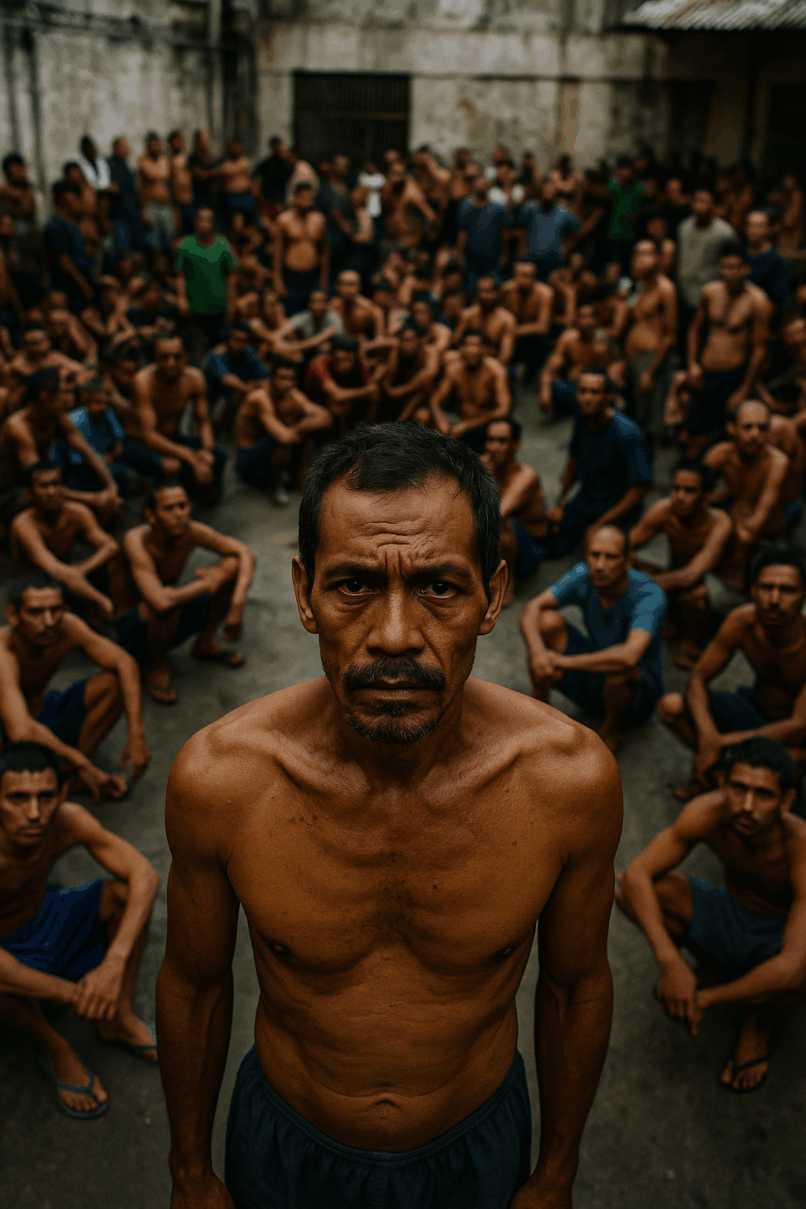
simply amazing, always for you.
Where the World Forgets
The purpose of prison, at least in theory, is rehabilitation. A place where society’s laws are enforced, where those who break them are meant to reflect, reform, and re-enter the world as better citizens. But in the darkest corners of the globe, there exist prisons so dangerous, so inhumane, that the word “rehabilitation” has no meaning. Inside these walls, justice is a distant concept. Survival is the only law.

This documentary article takes you deep inside some of the most notorious prisons in the world—facilities that have earned infamy not just for housing the world’s most dangerous criminals, but for becoming lawless realms of suffering, violence, and institutional decay.
1. Saydnaya Prison, Syria: The House of Death
North of Damascus, hidden in the cold hills of Syria, lies a prison so feared that even locals speak of it in hushed tones. Saydnaya Prison—nicknamed “The Slaughterhouse”—has become a symbol of President Bashar al-Assad’s reign of terror.
Former detainees speak of a place where mass executions occur regularly. Inmates are beaten into confession, subjected to starvation, and locked in windowless cells soaked in blood and sewage. Amnesty International once estimated that between 2011 and 2015 alone, over 13,000 people were secretly hanged at Saydnaya.
In some cases, entire wings are cleared in the dead of night. Survivors recall hearing the screaming stop all at once, only to be followed by eerie silence and the dragging of corpses. For many, being sent to Saydnaya is a death sentence with no trial, no hope, and no trace.
2. Evin Prison, Iran: Where Hope Dies in Silence
Built on the northern slopes of Tehran, Evin Prison has long held Iran’s intellectuals, journalists, dissidents, and dual nationals. Its name has become synonymous with torture and political oppression.
Cellblocks are overrun with surveillance, beatings, and psychological warfare. Solitary confinement cells—often called “coffins”—are designed to break the mind and spirit. Inmates are denied access to lawyers, families, and at times, even the outside light.
In June 2025, tragedy struck when an Israeli military strike targeted suspected military operations nearby, but the blast impacted the prison complex. At least 71 people died—many of them civilians in visiting areas. International outcry followed, but inside Evin, the terror simply carried on.
3. ADX Florence, USA: The Alcatraz of the Rockies
In the quiet deserts of Colorado stands the most secure federal prison in the United States—ADX Florence. But what sets this prison apart is not chaos, but its chilling precision.

Here, prisoners are locked in 12-by-7 foot cells for 23 hours a day. Meals are slid through a slot in the door. Human contact is minimal. Many inmates spend decades in solitary confinement, leading to mental breakdowns, hallucinations, and suicide.
Among its residents have been terrorists, cartel leaders, and serial killers. The facility is meticulously designed to prevent escape and communication—even with other inmates. It’s not the violence, but the absence of life, that makes ADX Florence so terrifying.
4. La Sabaneta, Venezuela: Hell in Overcrowded Flesh
Once declared by the Venezuelan government as one of the most violent prisons in Latin America, La Sabaneta in Maracaibo housed more than 25,000 inmates in a facility meant for 15,000.
Disease ran rampant. Guards were outnumbered. Gangs controlled entire blocks, issuing punishments and meting out justice on their own terms. In one notorious riot in 1994, over 100 prisoners were killed in a single day. The cause? A turf war over food rations.
In 2013, the government began emptying and eventually closed La Sabaneta. But its legacy remains a chilling reminder of what happens when a prison becomes a battleground.
5. Aragua Penitentiary Center, Venezuela: A City Within Walls
Tocorón prison, also known as the Aragua Penitentiary Center, is a twisted social experiment. Built to house 750 inmates, it swelled to over 7,000. But what makes it unique is who ran it—not the government, but a gang known as “Tren de Aragua.”
Inside, prisoners built their own society. A nightclub, a pool, a zoo, even underground escape tunnels. Guards stationed outside dared not interfere. Murder and extortion were daily rituals. Drug smuggling thrived. It wasn’t a prison. It was a gang stronghold with concrete walls.
In 2023, a military operation attempted to regain control, but by then, the damage was done. The prison had birthed a criminal empire that extended beyond its gates.
6. Black Dolphin Prison, Russia: Cold, Silent, Unbreakable
Near the border with Kazakhstan lies Russia’s infamous Black Dolphin Prison. It houses the worst of the worst: serial killers, terrorists, and cannibals. The name derives from a statue made by inmates—a black dolphin outside the gates.
Inmates are blindfolded whenever moved. They are bent at the waist, arms behind their backs. Cells are under constant video surveillance. Prisoners sleep under heavy regulation and face daily searches. Talking is prohibited unless spoken to.
Once inside, an inmate never leaves alive. There are no rehabilitation programs, no parole hearings, no visits from the outside world. Black Dolphin is the end of the road.
7. Bang Kwang Prison, Thailand: Shackled Until Death
On the outskirts of Bangkok sits Bang Kwang Prison, known ominously as the “Bangkok Hilton.” Here, death row inmates are chained at the ankles 24 hours a day. Executions by firing squad were once routine.
Conditions are squalid. Food is maggot-infested. Rats run across the floors at night. The sick often die untreated. Foreigners imprisoned for drug offenses make up a sizable portion of the inmate population, often unaware of the severity of Thai drug laws until it’s too late.
Bang Kwang is a stark symbol of a justice system where second chances do not exist.
8. Kamiti Maximum Security Prison, Kenya: Forgotten Behind the Walls
Originally built in 1954 during British colonial rule, Kamiti Maximum Security Prison has a long and tortured history. Located just outside Nairobi, it once served as a center for executions and political suppression.
Today, it’s overcrowded, underfunded, and marred by violence. Riots have broken out over food shortages, and reports of prisoners escaping with the help of guards are not uncommon. Disease spreads quickly, with poor sanitation and limited medical access.
Executions may have ceased, but Kamiti still carries the ghosts of its past.
9. Camp 14 and Camp 22, North Korea: Prisons Without Names
In North Korea, entire families are sent to labor camps for the perceived crimes of one member. The most notorious of these are Camp 14 and Camp 22—gulags that resemble Soviet-era horrors, only worse.
Public executions, starvation, and forced labor define daily life. Children are born into captivity, never knowing freedom. Inmates work in coal mines and fields for 16 hours a day. Escape is near impossible. Those who try are shot or disappear.
Defectors describe these camps as places where humanity itself has been erased.
10. Mile 2 Prison, The Gambia: The Shadow of Silence
Located near Banjul, Mile 2 Prison is cloaked in secrecy. Under former dictator Yahya Jammeh, it was used to silence dissent. Torture, solitary confinement, and mysterious deaths were common.
Even today, human rights groups are denied access. Families wait outside its walls for years, never knowing if their loved ones are alive. Justice, if it exists here at all, is out of reach.
When Prisons Become Tombs
Around the world, the idea of incarceration varies wildly. In some places, prisons are centers of reform. In others, they are forgotten hellholes, where justice dies and violence reigns.
These institutions exist out of public view, operating with little accountability and fewer consequences. While some argue that the worst criminals deserve the harshest punishment, what does it say about a society when it turns a blind eye to systemic cruelty?
Prisons are not meant to be death sentences. They are not meant to crush the soul. But in these walls of silence and suffering, they do exactly that.

Support Our Website!
We appreciate your visit and hope you find our content valuable. If you’d like to support us further, please consider contributing through the TILL NUMBER: 9549825. Your support helps us keep delivering great content!
If you’d like to support Nabado from outside Kenya, we invite you to send your contributions through trusted third-party services such as Remitly, SendWave, or WorldRemit. These platforms are reliable and convenient for international money transfers.
Please use the following details when sending your support:
Phone Number: +254701838999
Recipient Name: Peterson Getuma Okemwa
We sincerely appreciate your generosity and support. Thank you for being part of this journey!
